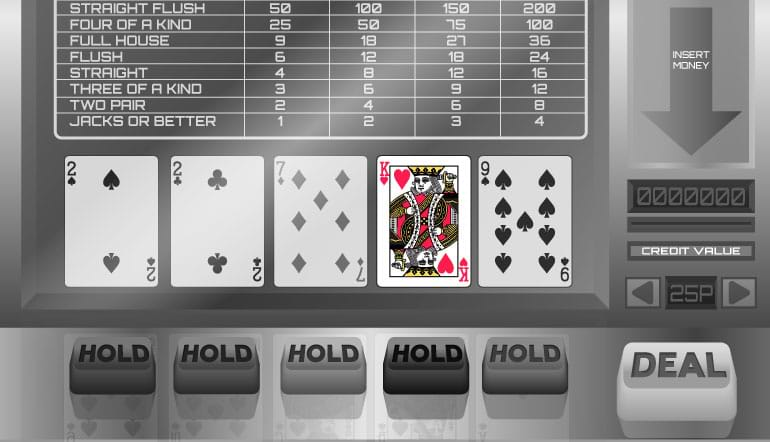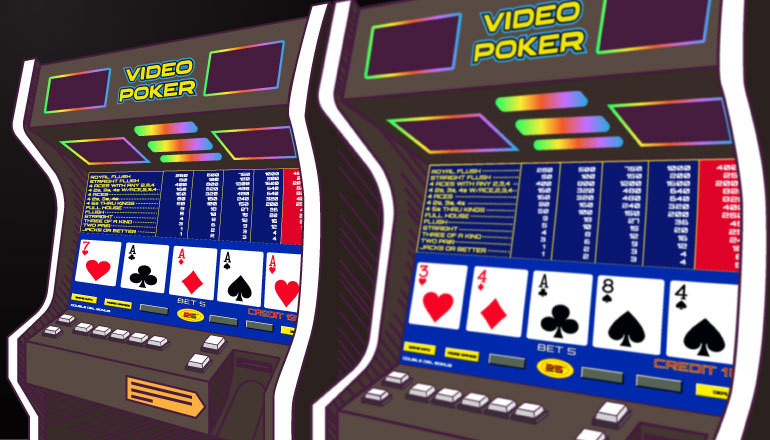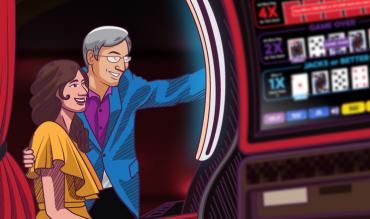The double up feature has been around for decades. In fact, it was much more prevalent years ago than it is currently. The following true story could be the reason why.
In April, 2009, John Kane was playing video poker in the Fremont Casino in downtown Las Vegas. A little background on Kane is in order. Kane was truly addicted to video poker. In 2006, he lost half a million dollars playing video poker at Boulder Station and earned enough Player Club points to pay for his own Game King which he set up in his home on the outskirts of Las Vegas. He had a measured temperament and was not prone to emotional outbursts. Rather his play was methodical.
On this particular day, he was playing a row of four low limit Game King machines. He had been switching between the different games available on the machines and had accumulated a decent win. When he hit the Cash Out button to take his money to a different game, the screen locked up and the light above the machine lit indicating a jackpot worth more than $1,200. Kane knew it must have been a mistake and actually told the slot attendant so. The attendant thought he was joking and paid him anyway.
Knowing there was a programming error, Kane vowed to determine how to exploit it. He called a friend, Andre Nestor who lived in suburban Pittsburg, to tell him about it. Nestor flew to Las Vegas the next day. Together they went to the Fremont to try to recreate Kane’s previous results. They were able to determine that the key to the glitch was that under the proper circumstances, the denomination could be switched retroactively making a $40 jackpot at the penny level into a $2,000 jackpot at the 50-cent level.
It took them seven hours of playing side-by-side to come up with a repeatable sequence to profit from the glitch.
Realizing they should spread their play around, they tried their technique elsewhere. They tried Game Kings at the Hilton, the Cannery, the Stratosphere, Terrible’s, Hard Rock, Tropicana, Luxor and five other casinos – all to no avail. They were not able to recreate their results at any of these other casinos.
So, they returned to the Fremont. In order to increase profits, they started using the double up feature. Ultimately casino personnel noticed the winnings. The slot manager approached Kane after one of his wins and announced he was disabling the double up feature on all Game Kings as he figured this must have something to do with his winning streak at video poker.
This didn’t bother Kane as he knew the bug, not the double up feature was the real secret of his success. To his surprise, the magic sequence no longer worked at the Fremont. That’s when he realized that the sequence worked with the double up feature turned on but it did not work with the feature turned off.
Armed with this new information, all the Game Kings in the country were their personal banks – as long as they could get the slot attendants to enable the double up feature.

Fast forward. As with all such situations, Kane and Nestor were ultimately caught, the machine’s erroneous code was corrected, and once again, the casinos had the upper hand.
If you are curious, here are the steps they used to “beat the house.”
The “Double Up bug” in the software of Game King video poker machines sur-vived undetect¬ed for nearly seven years, in part because the steps to repro¬duce it were so complex. This is what they did.
- Locate a Game King video poker machine con¬figured for multi-denomination play.
- Flag down a slot attendant and ask them to enable the Double Up option.
- Insert money or a voucher and select the lowest denomination level offered by the machine — for example, $1 per credit on a $1, $2, $5, $10 machine.
- Choose your favorite game — and start playing.
- Keep playing at the minimum level until you win a big hand. An $800 royal flush is perfect.
- With your royal flush showing but not yet cashed out, hit the More Games button on the touchscreen and select a different game variation. Play it until you score a win.
- Insert more money or a voucher into the machine.
- Touch the More Games button again, and change to the maximum denomination — in this case, $10 per credit. Then return to your original $800 royal flush.
- Press the Cash Out button. “Jackpot! $8,000” will appear on the screen and the light on the top of the machine will illuminate.
- Wait for the slot attendant to show up with an IRS form W-2G. Once you've signed it, you'll get your money.
Now that this bug has been resolved and the above 10 steps are worthless. So, let’s look at regular double up play.
HOW DOUBLE UP WORKS
The double up feature is only available after a winning hand. When made, there are different methods to play the double up feature. Some games will automatically ask if the player wants to double up. On other games a “Double Up” button will become highlighted and the player has to touch it to activate the feature.
- Once the double up feature is selected, five cards are dealt – one card face up and four cards face down.
- The object is to select a face down card that will beat the face up (or house) card.
- If the player selects a card that beats the house card, he or she will double the original win.
- If a card lower than the house card is selected, the player loses the entire win.
- If the selected card is the same rank as the house card, most games treat it as a push. However, some games will treat this as a player loss.
- It is important to ascertain whether ties are treated as pushes or losses as this greatly impacts results.
Most games allow the player to double up any winning hand – including winning double ups – but some only allow the player to double up once per initial winning hand.
Keep in mind the five cards that are dealt are chosen exactly the same way that regular video poker hands are chosen – by using the RNG (Random Number Generator). In other words, they are dealt as randomly as a machine can.
So, is the double up feature a good thing or a bad thing? Let’s try to answer – to Double Up or not to Double Up – that is the question.
Let’s look at the good first.
- Assuming that ties are treated as a push, the return for double up is 100 percent. There is no casino edge. Unless you have been able to locate a (currently extremely rare) 100+ percent game, the return for double up play is greater than the return of the base game.
- Just make sure the double up feature you are playing treats ties as a push. If not – if a tie is treated as a loss – you are facing 5.8 percent house edge. This is not playable. Avoid playing it.
- The double up feature adds some excitement to the game. A 400 credit win can become 800 credits, or 1,600 credits, or 3,200 credits or more.
Now for the bad.
- Playing the double up feature dramatically raises the game’s variance. Sure, you can win money more quickly using it, but you will also lose more quickly since half of all your double up plays will cost you your original win.
- The playing rhythm becomes interrupted when switching to double up play and back to regular play. This can have adverse effects on perfect play
Okay, there are good and bad aspects of playing double up, so let’s summarize. Here are some things to consider when deciding to play the double up feature.
- Is the return of the base game over 100 percent? If yes, do not play the double up feature.
- If the return of the base game is relatively low (95-98 percent), you may be better off looking for a higher return than playing double up in order to compensate.
- Does the double up feature treat ties as pushes or a losses? If ties are treated as losses, do not play the double up feature.
- How risk averse are you? If you have trouble watching pevious wins evaporate, do not play the double up feature.
- Do you have a substantial enough bankroll for the added variance of double up? If not, do not play the double up feature.
- Does changing the rhythm and pace of the game that happens when you switch from regular VP play to double up play bother you? If yes, do not play the double up feature.
- Does the added excitement of playing the double up feature make up for the increased variance oof double up? If so, and if you have an adequate bankroll, playing double up could be for you.
As you can see, there are many reasons to avoid playing double up and precious few supporting play. In other words, proceed cautiously with double up play.
Here are a couple of other things to consider if you decide to play double up:
- Should you play double up on every win or less than that?
- Should you play double up more than once per win?
- Remember, every time you play double up, you increase variance. The more you play it, the larger your bankroll should be

There are a lot of things to consider, but the bottom line is playing the double up feature is a very personal decision. There are no clear cut guidelines that say a player should play it. Ultimately, it is up to the player to decide what is important and if they have what it takes to ride through the rollercoaster ride of playing the double up feature.
That’s it – everything you need to know about playing the double up feature on video poker. What is YOUR answer to the question – to double up or not to double up? Only you can say.
You can contact Jerry “Stickman” at stickmanjerry@aol.com


